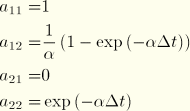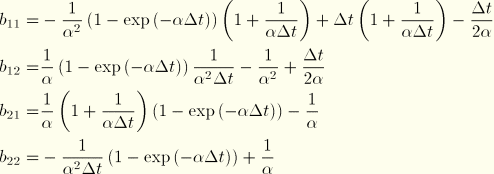
Product: ABAQUS/Standard
The modal dynamic procedure provides time history analysis of linear systems. The excitation is given as a function of time: it is assumed that the amplitude curve is specified so that the magnitude of the excitation varies linearly within each increment. When the model is projected onto the eigenmodes used for its dynamic representation, we obtain a set of uncoupled one degree of freedom systems, for any of which the equilibrium equation at time t is
whereThe solution to this equation is readily obtained as a particular integral for the loading and a solution to the homogeneous equation (with no right-hand side). These solutions can be combined and written in the general form
whereThere are three cases of this solution for nonrigid-body motion (![]() ), depending on whether the damping in the modal equilibrium equation is greater than, equal to, or less than critical damping (that is, depending on whether
), depending on whether the damping in the modal equilibrium equation is greater than, equal to, or less than critical damping (that is, depending on whether ![]() is positive, zero, or negative).
is positive, zero, or negative).

If there are rigid body modes in the finite element model, there will be one or several eigenvalues that are zero. The equation of motion (Equation 2.5.5–1) is reduced to
Only Rayleigh damping can be specified for a rigid body mode, since the critical damping is zero. Furthermore, since it is a rigid body mode, only the mass damping factor, ![]() , appears (stiffness damping requires that there be straining of the body). For this case
, appears (stiffness damping requires that there be straining of the body). For this case



For the particular case of a rigid body mode without damping, the equation of motion (Equation 2.5.5–1) is reduced to
For this case

The time integration is done in terms of the generalized coordinates, and the response of the physical variables is then immediately available by summation:
![]()
![]()
![]()
![]()

At the beginning of the step initial displacements and initial velocities must be converted to equivalent values of the generalized coordinates, which can only be done exactly if the number of eigenvectors equals the number of degrees of freedom. Since this is usually not the case, the initial values of the generalized coordinate displacement and velocity are calculated as
![]()
Similarly, for initial velocities
![]()

Many linear dynamic problems involve finding the response of a structure to a “base motion”: a time history of displacement, velocity, or acceleration given for the points where the displacements of the structure are prescribed. In all cases these base motions are converted into an acceleration history. If the displacement or velocity history has nonzero values at time ![]() 0, corrections to the acceleration histories are made at times
0, corrections to the acceleration histories are made at times ![]() 0 and
0 and ![]() . If velocities are given, the acceleration at
. If velocities are given, the acceleration at ![]() 0 is
0 is
![]()
![]()
If velocities are given for tabular or equally spaced amplitude curve definitions, the acceleration is defined by the central difference rule
![]()
![]()
The response is calculated relative to the base. If total values of nodal variables are required, the motion at the base is added to the relative values:

